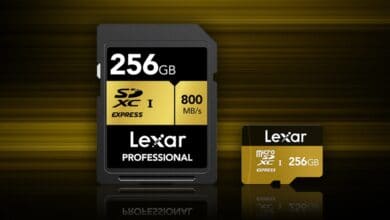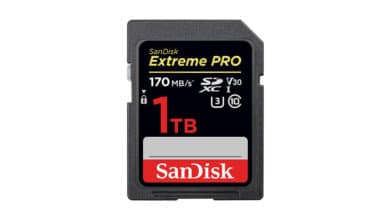
You want to download an app or a new photo to your phone or smartphone, but suddenly you get the error message “Memory full”? Don’t worry: There is a simple solution: the memory card! At least, that’s true as long as you don’t have an iPhone. Apple has not provided its devices with a slot in which such a card can be inserted. Nevertheless, there are solutions here as well – we’ll get to that later.
The advantages of memory cards
Memory cards have become indispensable, especially for small devices such as digital cameras, GPS devices and cell phones. They come in a wide variety of capacities and speeds – what should be purchased depends on the application. Speed and plenty of storage space is needed by those who load many and/or large files.
Memory cards can be used to store important information at will. The cards allow you to store videos, photos and music. A great advantage is that information can be deleted and overwritten again as desired. This is why memory cards are also very important for documenting private documents, photos, certificates or job applications, because if the device ever crashes or is stolen, you retain all the relevant information, as long as the card has been removed from the device and stored safely.
Whether as Compact Flash, Micro Drive, Secure Digital, Memory Sticks, Multimedia or xD Picture Card – memory cards are commercially available in various designs and storage capacities. For the mobile phone sector, however, one form has prevailed in recent years – the so-called SD memory card.
SD memory cards
Behind the term “Secure Digital Memory Card” (short: SD memory card) is a digital storage medium whose mode of operation is based on the principle of flash storage. The SD card was developed in 2001 by the US company SanDisk, using the older MMC standards as a starting point. While the SD card only had a capacity of eight megabytes at that time, today there are corresponding cards with a capacity of over 500 gigabytes.
The larger the storage capacity of the SD card, the more pictures, video sequences and other data can naturally be stored on it. If you no longer need the data or want to store other content on the SD card, you can easily delete it or transfer it to a PC or laptop.
Application areas of the SD card
SD memory cards can be used in conjunction with many different devices these days. For example, many consumers use them to take photos in digital cameras and to back up a wide variety of data in smartphones and cell phones. Mobile navigation systems rely on SD cards to store map material, as do some handheld consoles to back up game scores.
Many devices that have an SD slot are often also backwards compatible with MMC cards, i.e. MMCs can also be used in these devices even though they are actually designed for SD cards. However, the reverse is not possible, i.e. the use of SD cards in connection with devices designed for MMC cards.
microSD and microSDHC/SDXC memory cards
Today, so-called microSD memory cards are usually used in modern Android phones or smartphones. MicroSD cards are a very compact flash memory card format, which is identical to normal SD memory cards in electronic terms.
The additional designations microSDHC and microSDXC do not refer to different technologies, but only to the storage capacity:
- Cards that include a maximum storage capacity of 4 GB up to 32 GB are named microSDHC.
- Cards that include a maximum storage capacity of 32 GB up to 2 TB are named microSDXC.
The U.S. company SanDisk originally produced the microSD format under the name T-Flash, before this changed to TransFlash. However, it should not remain here, because as a result of the adoption by the SD Card Association (SDA; association of the three companies Panasonic, SanDisk and Toshiba) changed the name of the format another time in the nowadays common microSD.
microSD features
microSD cards, with dimensions of just 11 mm × 15 mm × 0.7 mm and a weight of 0.4 g, are not only very compact, but also extremely lightweight. They are also ideal for larger amounts of data, as the available cards easily meet any requirements with their large storage capacity.
Basically, microSD cards are actually SD memory cards with a smaller housing, so the same electronic specifications apply to both. Consequently, in addition to SDHC and SDXC, there are also corresponding microSDHC and microSDXC cards available on the market, which convince with an even higher storage capacity and are divided into different speed classes.
Application areas & Compatibility of microSD cards
microSD cards are most commonly used in mobile devices, such as cell phones, due to their small size and light weight. Other flash memory card formats recognized by the SDA also include miniSD as well as SD. Both microSD and miniSD cards can be used in conjunction with SD-compatible devices with the help of a mechanical adapter. Nowadays, said adapters are often included in the scope of delivery and therefore do not always have to be purchased as an option.
3 Recommended Memory Cards
SanDisk Ultra Android microSDXC UHS-I memory card 128 GB
The SanDisk microSD memory card is ideal for use in Android smartphones and tablets. With a whopping 140 MB/s transfer speed and A1 App Performance, the microSD memory card meets the latest performance standards and ensures smooth app performance. Thanks to U1 and Class 10, the microSD card can record full HD videos and play them back without any problems.
Samsung EVO Select microSD Memory Card
The Samasung EVO Select locking memory card is optimized for speed, making it perfect for use in smartphones, tablets, cameras and drones. The high speed enables 4K UHD and Super Slow Motion recording with up to 130 MB/s transfer speed. Thanks to 256GB storage capacity, it offers up to 12 hours of recording time of 4K UHD videos.
Lexar Micro SD Card 32GB 2-Pack
Affordable Micro SD cards in a 2-pack of 32 GB for read speeds up to 100 MB/s. The memory card 32 GB supports UHS-I, U1, A1, speed class 10, video speed class 10 (V10). In short, an ideal Micro SD card for all smartphones, tablets, drones, cameras and other Android compatible devices. It is also shockproof, waterproof, temperature proof, X-ray proof and magnetic field proof.
Special case iPhone: How can the memory be expanded here?
As already alluded to in the introduction, Apple does not allow its iPhone users to expand the storage space by means of an SD card or microSD card. There is simply no card slot available. However, there are still various ways to expand the storage space on an iPhone:
Using iCloud
iCloud is an online storage service from Apple that allows you to store and access photos, videos, music, and other files in the cloud. When you enable iCloud, your photos, videos, and other data are automatically backed up to the cloud and deleted from your iPhone to free up the appropriate storage space.
Use external storage
There are external storage devices that are compatible with iPhone and can expand the storage capacity of your iPhone. Examples include the iXpand from SanDisk or the i-FlashDrive from PhotoFast.
Delete unneeded data
The easiest way to free up storage space on your iPhone is to delete data you don’t need, such as photos, videos, apps, or music. Also, if you have a lot of apps on your device that you no longer use, you should uninstall them. By doing so, you can free up extra storage space and improve your iPhone’s performance.
Use a memory optimization app
There are many apps on the App Store that can optimize the storage space on your iPhone. Some of these apps scan the device for unneeded files and delete them automatically to free up storage space. Examples of these are CleanMyPhone or PhoneClean.
Note that some of these options are paid and/or require additional hardware.

